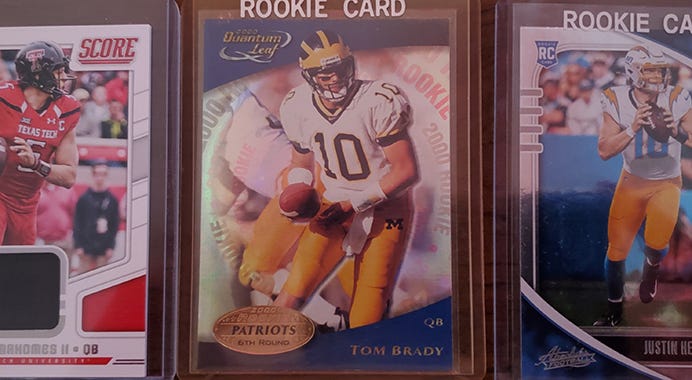How Many Sports Cards Parallels Do We Need?
It seems every sports card set has multiple parallels and "1 of 1" cards to chase. But how good is that for the hobby?
The other day, I ran across a tweet that indicated that Trevor Lawrence, the No. 1 overall pick of the 2021 NFL Draft, has quite a few "1 of 1" trading cards.
Just how many does he have? Allow me to present the tweet.





That figure comes just as 2021 Donruss Optic was released and 2021 Select is on the way. Yes, there is still 2021 NFL product being rolled out, thanks to delays in production.
The fact 2021 sets are still being rolled out, even as 2022 NFL cards have started hitting the shelves, is another topic for another day. Let's get back to the 1,000-plus "1 of 1" trading cards that Lawrence has.
On one hand, you can have a "1 of 1" that is unique to a particular set. On the other hand, the more that such cards are on the market, the less unique they become.
The "1 of 1" practice dates back to the 1990s when card companies were trying to top one another in the "rare card" department. Fleer put "1 of 1 Masterpiece" cards into its Ultra products, at a time when cards were all over the place.
While sports cards are not in as many locations now as they were back then, that doesn't mean they suddenly became "rare." Yet with the recent sports card craze that emerged during the pandemic, when people wanted to find something to spend money on, it seems to have only fueled the incentive to put out more parallels.
The "1 of 1" craze isn't just limited to Panini. Topps is putting "1 of 1" cards into its products. This includes Opening Day baseball, which is supposed to be for those who are on a budget (primarily kids). That we are putting parallels like that into one of the cheapest products available is a sign that this craze is going too far.
The parallel craze isn't limited to "1 of 1" cards, though. 2021 Panini Prizm football has 16 different Prizm parallels in hobby boxes alone. Then there's the retail product, in which you have blaster boxes, mega boxes and value packs, which account for 10 more parallels. There's even a "T-mall" box that has two types of parallels in it. All told, there are 28 different parallels in just one set.
And get ready for Topps Chrome baseball, which is expected to have a lot of parallels, too. Per information released all the way back in November of last year, there will be 28 different Refractor parallels in that set.
While I think the Prizms and Refractors are cool inserts, to have 28 different versions of them is excessive. That's particularly true when you are doing parallels of cards for players in which there isn't much collector interest.
Panini Prizm football had a 330-card base set, in which the company put a lot of retired players into the set, and even went as far as to add a card for WWE talent Brock Lesnar, who tried out for the Minnesota Vikings a few years ago. Topps tends to make its Chrome set smaller in terms of the base set -- it's expected to be 200 cards.
Still, how many parallels can the trading card market take? Topps has 12 different parallels in its primary baseball set, plus photo variations for each card. Panini is going to tone down the parallel craze for 2022 Score football with eight variations of base cards in its hobby boxes, but who knows what they have planned for retail product.
The pandemic may have pulled more people back into the hobby, but it's hard to see the hobby being able to accommodate so much in the way of parallels. And as for the "1 of 1" cards, one player with 1,000 such cards from different products doesn't mean those cards are in mass quantities. But it does mean the cards aren't as special as they might be otherwise.
Furthermore, if there's a "1 of 1" for every single player in a set, you'd be hard pressed to find buyers for them all.
Let's take the 1998 Fleer Ultra football set. Peyton Manning and Randy Moss had their rookie cards in that set, so the "1 of 1 Masterpiece" variations would no doubt sell for a lot. However, what interest will there be for the "commons" in the set such as Paul Justin, Erik Kramer, Tommy Vardell and David Dunn? It's hard to imagine anyone showing interest.
Sometimes getting a card that's numbered to just a handful of copies can be a great thing. I have an Ezekiel Elliott autographed card numbered to 10, along with an autographed card of Brooks Robinson numbered to 10. But with the amount of parallels out there, it's harder to look at such numbered cards as being that special.
With Fanatics set to take over the NFL and NBA licenses in the near future, it might be time to ask them to take a different approach. Some parallels numbered to just a few copies are fine, but too many of them means there's less appeal.
Furthermore, the point about getting people to enjoy the trading card hobby is to pursue players they like or sets they like, rather than fueling a craze about parallels.
It was nice to see more people get into the hobby again, but now that most activities unavailable during the pandemic are offered again, those who got back into sports cards will have to make choices.
Panini and Topps may want to think about their own choices and ask themselves how many sets really need multiple parallels and, in particular, cards numbered "1 of 1."



